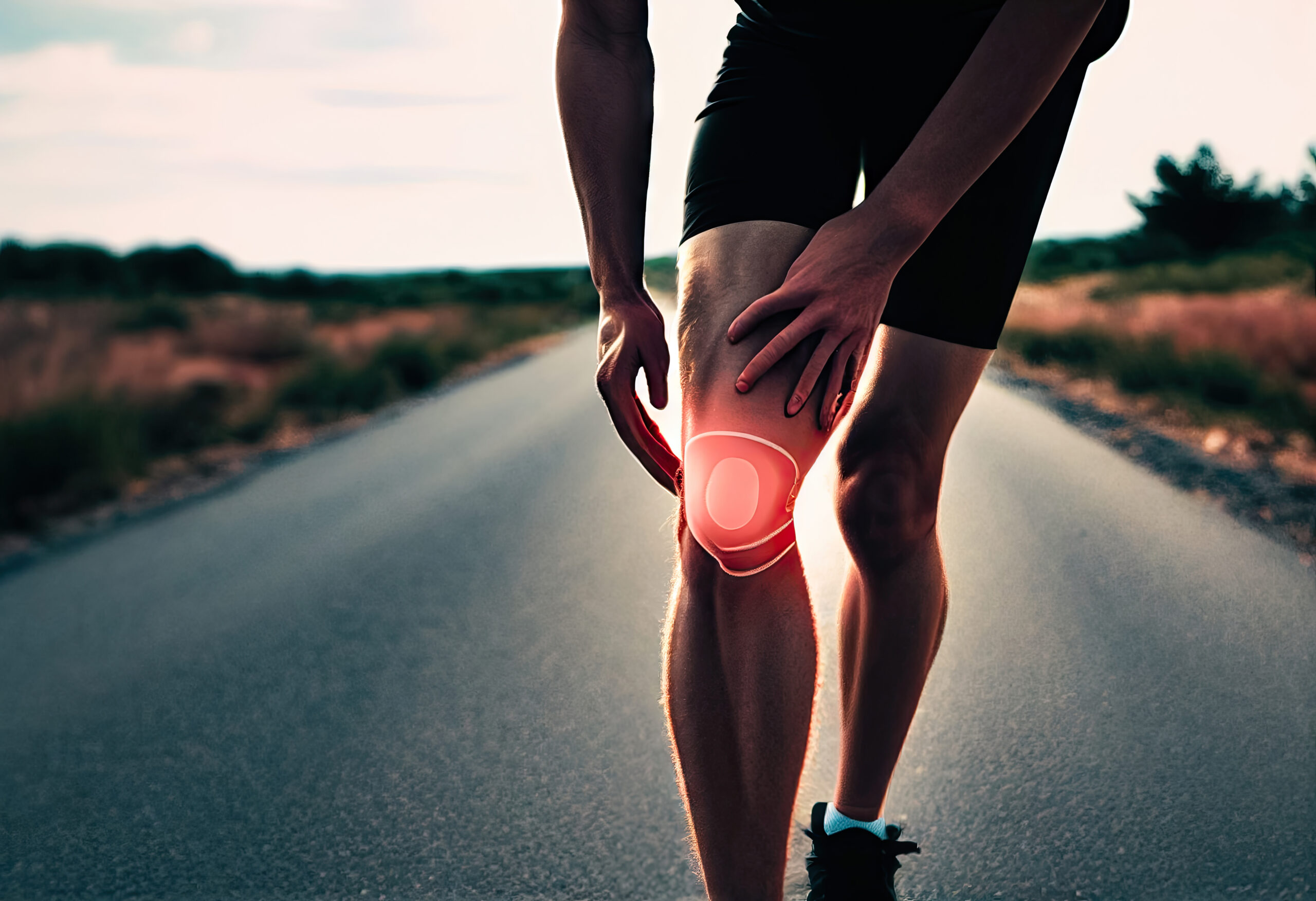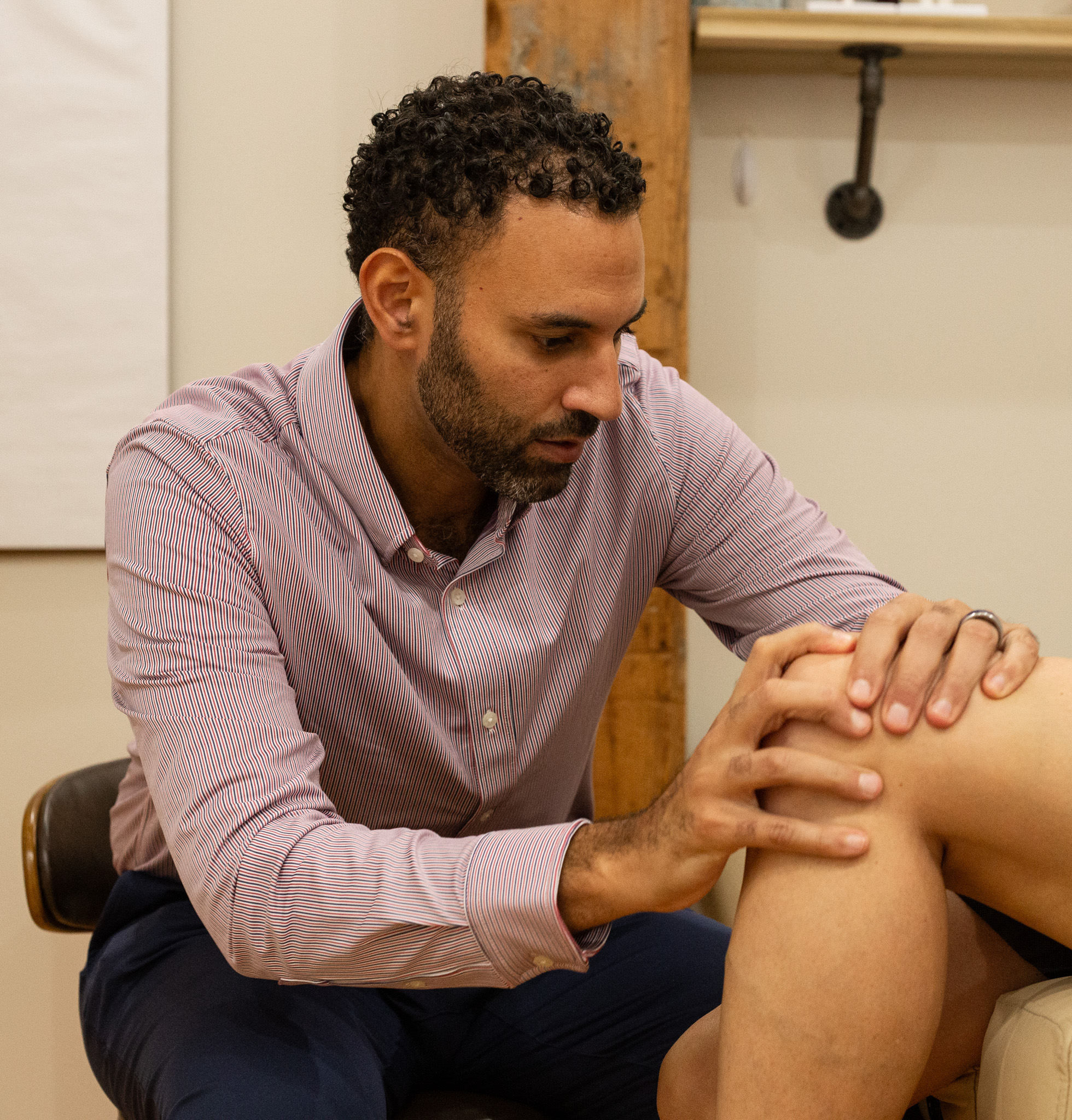
Knee Pain treatment in Philadelphia
At Meeting Point Health, we offer a comprehensive selection of functional and regenerative treatments designed to meet a variety of health and performance needs.

TABLE OF CONTENTS

Regenerative Orthopedics for Knee Pain Relief
The knee is a complex hinge joint made up of the femur, tibia, and patella, with cartilage and ligaments ensuring smooth movement and stability. Four main ligaments—MCL, LCL, ACL, and PCL—provide support, while the meniscus acts as a shock absorber, protecting the joint from wear and tear during activities like walking and running.
At Meeting Point Health, we offer regenerative orthopedic treatments like PRP and stem cell therapy to address knee pain, helping repair damaged tissues and restore mobility without surgery. Whether it’s ligament injuries or meniscus damage, our treatments aim to provide long-term relief.
What are the symptoms of a knee injury?
Pain when resting and during movement that is either localized or systemic
Stiffness
Limited range of motion
Instability
Localized swelling
“Locking” sensation
A loud popping sound
If you’re experiencing these symptoms, it’s important to seek an evaluation to determine the best course of treatment. At Meeting Point Health, we specialize in personalized care to reduce pain, restore mobility, and prevent further damage. Call us today to request a consultation.
What are common knee injuries?
Meniscus Tear
ACL injuries
Knee Bursitis
Patellofemoral syndrome
Knee Tendonitis
Collateral ligaments
Patellar Tendonitis
Osgood–Schlatter disease
PCL injuries
Knee Arthritis
Cartilage defects
Dislocation
Knee Fractures
Iliotibial band syndrome
Knee Osteoarthritis
Sprains and Strains
Housemaid’s knee
Sports Injury to Knee
A ligament tear is an injury to the soft tissue of the ligament, which prevents the individual from moving, pivoting, turning, or twisting the leg. Ligament tears can result from contact (sports events or running) and non-contact activities (changing directions quickly, walking on uneven ground, or landing from jumping). The symptoms of a torn ligament can be painful, including swelling, inflammation, and tenderness around the injury site. Once the injury occurs, it can result in difficulty bearing weight, instability, and popping sounds during movement.
A meniscus tear is a common knee injury that can be caused by trauma to the cartilage or degeneration over time. An acute injury to the meniscus is painful, resulting in swelling, stiffness, instability, weakness, and unusual sounds, such as clicking or popping. A tear will limit mobility and movement. An acute tear could be due to physical activity or knee trauma, such as twisting or pivoting the joint.
On the other hand, a degenerative tear is gradual and the meniscus cartilage weakens and thins over time. It can be due to aging or repetitive movements. As the cartilage deteriorates, it becomes more susceptible to injury. Non-contact trauma, such as walking or running, could result in tears.
Finally, abnormalities in bone structure within the knee joint could result in meniscus tears. Abnormalities could include an uneven weight disposition, being unbalanced when completing physical activities, or improper knee alignment.
Whether the change in structure is acute or gradual, both are painful and limit the motion of the joint.
Osteoarthritis is a degenerative joint disease when the cartilage between the joints breaks down or tears. The bones without the cartilage rub against each other, resulting in friction which is painful and causes stiffness and swelling. As cartilage begins to wear, all the structures of joints including bones, ligaments, and tendons, can be affected by degeneration.
The symptoms experienced can lead to less activity, which results in muscle weakness. With muscle weakness, the shape of the joint begins to alter leading to the stretching of ligaments and tendons. Bone spurs may begin to develop, which changes the shape of the bones in the joint. Bone spurs develop as the body’s way to protect itself, however, they further limit the range of motion and cause pain. Pieces of bone or cartilage can bud off and float within the joint space, as a result, the symptoms are increased.
Certain factors can affect the development of osteoarthritis, such as:
- Aging
- Family history
- Knee injury or surgery history
- Obesity or being overweight
- Involvement in contact activities or sports
- Overuse or repetitive movements (ex. Jumping or running)
How to diagnose a knee injury at meeting point health?
At Meeting Point Health, the first stage is the assessment phase. Dr. Matta will review the patient’s medical history, conduct a physical examination, and perform ultrasound-guided imaging. Dr. Matta will inquire about the patient’s symptoms, occupation, and activities that may contribute to the condition. During the medical history, Dr. Matta will ask about the individual’s symptoms, including the location and duration of the pain, limitations in joint mobility, and the effect on the patient’s daily activities or routine. Dr. Matta will guide the patient through a series of motions to gauge the patient’s range of motion, and signs of inflammation or swelling, and the patient’s gait will be observed. The patient’s pain tolerance, stability, and movement will also be monitored. In addition, past medical records, recommendations, and imaging are beneficial to review. Finally, Dr. Matta may use ultrasound to view the internal structures of the knee area.
Knee Pain Treatment Options in Philadelphia
Explore a range of effective treatment options for knee pain at Meeting Point Health. Our personalized approach includes various knee pain therapies designed to address the root causes of your discomfort.
Contact Meeting Point Health today to schedule your personalized consultation and start your journey to relief. Your path to recovery begins here!
Prolotherapy is a medical injection procedure. The goal is to relieve pain and promote healing of musculoskeletal conditions, especially those involving ligaments, joints, and tendons Prolotherapy stimulates healing and tissue repair by causing an inflammatory response that increases blood flow and the arrival of immune cells and growth factors to the injection area.
Platelet-rich plasma PRP therapy is a medical treatment that involves the use of a patient’s own blood to promote healing and tissue regeneration. Once injected, the growth factors and other bioactive substances in PRP work to accelerate tissue repair, reduce inflammation, and promote the formation of new blood vessels. This helps in reducing pain, improving function, and enhancing the overall healing process.
Stem cell injection therapy refers to a medical procedure in which stem cells are harvested and then injected into a localized area on a patient’s body, typically to promote tissue repair, and regeneration, or to treat various medical conditions. Stem cells are unique because they can develop into different types of cells in the body, and they also have the capacity for self-renewal. This makes them valuable in medical treatments, as they can potentially replace or repair damaged or diseased tissues. Stem cell injection therapy can treat arthritic joints, sports injuries, tendinopathies, non-union fractures, meniscal tears, Degenerative Disc Disease, and Osteonecrosis or Avascular Necrosis.
Prolozone therapy is a mixture of ozone gas and a prolotherapy solution is injected into the affected area, often around joints, ligaments, or tendons. The theory is that this combination not only irritates and strengthens the tissues (like prolotherapy) but also delivers the potential therapeutic benefits of ozone, such as improved circulation and tissue oxygenation. Prolozone combines procaine, dextrose, B vitamins, saline, oxygen, and ozone into a damaged joint and the combination allows for regrowth of damaged tissue.
Nerve hydrodissection is a minimally invasive medical procedure involving injecting an anti-inflammatory solution around an entrapped nerve. Injectables such as dextrose, vitamins, peptides, plasma, procaine, and even stem cells are flooded around compressed or irritated nerves. This technique aims to separate the affected nerve from surrounding structures, such as muscles, fascia, or scar tissue, which may be contributing to the pain or dysfunction.
Peptide Therapy can be introduced as an at-home treatment. Peptide therapy introduces peptides to signal communication with our cells to perform a specific response. Administrating peptides elicits a response to regulate or improve physiological functions. For regenerative medicine, peptides for wound recovery, and tissue repair, reduce inflammation, accelerate recovery time, and promote cell migration and differentiation.
How to prevent a knee injury?
After knee pain treatment, preventative measures can be taken to reduce the risk of additional or further injury.
A few strategies are:
Engage in strengthening, physical therapy, or flexibility exercises
Braces or crutches
Maintaining a healthy weight
Exercise
Healthy lifestyle
Wearing protective gear, such as knee pads
Slowly increase the duration and intensity of exercises
Listen to your body – rest when needed
Soul-Centered Healthcare As a Catalyst For Change
Many people suffer with undiagnosed or misdiagnosed conditions and simply don’t know what’s wrong with them or what will help. We understand what it’s like to feel trapped in a body that is not working for you! At Meeting Point Health, we find the root cause and use a proven, integrative approach that gets results. As highly trained pioneers in functional and regenerative medicine, we’ve helped thousands of patients take control of their health.
OUR PATIENTS FIND RELIEF HERE
Our Patients Find Relief Here
EXCELLENT
We’re here to answer all of your questions
Schedule a call with one of our onboarding specialists today so they can answer all of your questions.
Does Meeting Point Health accept insurance?
Meeting Point Health does not accept insurance.
Our practitioners and staff fully understand and empathize with the challenges that patients face as they make financial decisions for proper health care. Our practice is very different from a conventional medical practice in many ways, but the time spent with each patient is usually 30-90 minutes. Visits with a physician covered by insurance generally allow for less than 10 minutes in total! Conventional medical practices that take insurance maintain brief office visits and high patient loads for this reason. We cannot provide the expert care that every one of our patients deserves under those circumstances.
Insurance also dictates the types of treatments and order of treatments patients can receive for a particular condition.
Opting out of insurance allows the patient and the doctor to maintain their medical autonomy, which is imperative to ensure you get the right treatment at the right time and the right dose.
Can I get an insurance reimbursement?
How do I get started with Meeting Point Health?
To start your journey to relief, schedule a consultation with our team. During your initial visit, we’ll assess your medical history, perform a thorough evaluation, and develop a customized treatment plan to address your specific needs. Click to schedule a free discovery call with one of our Patient Onboarding Specialists today!

